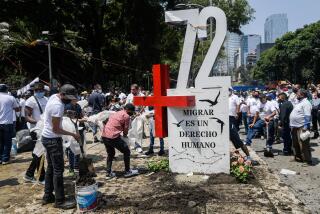Henry Ynostroza, 82; Wrongly Convicted in ‘Sleepy Lagoon’ Killing
- Share via
Henry Ynostroza, a defendant in the infamous 1942 “Sleepy Lagoon” murder case in which 12 young Mexican American men were unjustly convicted of the murder of a young Mexican national, has died. He was 82.
Ynostroza, a retired warehouse supervisor, died of natural causes Tuesday at a convalescent home in Pasadena, said his daughter, Marie Ruvalcava.
Ynostroza, who grew up near 38th Street in Vernon, began working at age 15 to support his mother and two sisters after his father was deported to Mexico. He was an 18-year-old married father of a year-old daughter when he was arrested in connection with the “Sleepy Lagoon” murder case.
The ensuing trial raised constitutional issues and is credited with playing a landmark role in the development of Latino civil rights.
Late in the evening on Aug. 1, 1942, several Mexican American youths from Ynostroza’s 38th Street neighborhood got into an altercation with members of a Downey gang at a rural reservoir that was used for swimming by Mexican Americans, who were denied access to the city’s segregated public pools.
After returning home and rounding up more friends, including Ynostroza, they drove back to the reservoir, which was nicknamed “Sleepy Lagoon” after a popular song.
When they got there, Ynostroza told The Times in 2001, the area was deserted. But hearing music from a party at an adjacent ranch and thinking the Downey gang members might be there, they drove to the ranch. Shortly after they drove up, a brutal melee broke out.
After the 38th Street cars departed, farmworker Jose Diaz, who had been stabbed, severely beaten and hit on the head with a blunt object, was discovered lying semi-conscious in the middle of a dirt road with his pockets turned inside out; he died 1 1/2 hours after being taken to a hospital.
Police rounded up hundreds of young men and women, most of them Mexican Americans, for questioning.
The grand jury indicted 24 young men, including Ynostroza, on charges of conspiracy to commit murder and assault with a deadly weapon.
Two of the indicted men had their cases heard separately, but charges were dismissed because of a lack of evidence.
The remaining 22 defendants were tried en masse, facing what critics have called an atmosphere of hostility and prejudice toward Mexicans and Mexican Americans.
The defendants, who were being held in Los Angeles County Jail, were prevented by the prosecutors from getting haircuts or changing clothes until weeks into the three-month trial. The defense objected on the grounds that “the boys looked like mobsters, like disreputable persons.” But Judge Charles W. Fricke ruled against the motion.
Instead of the defendants being seated next to their lawyers, they sat in rows of chairs at the side of the courtroom. Fricke ignored defense attorneys’ objections about the seating arrangements, which prevented the defendants from conferring with their lawyers during the proceedings.
“It was so much worse when you saw the expression of Judge Fricke,” Alice Greenfield McGrath, who served as executive secretary of the Sleepy Lagoon Defense Committee, told The Times in 2002. “He despised the defendants.”
McGrath said Fricke also “insulted” defense attorney George Shibley. And, she said, “if the prosecutor made an incorrect motion, Fricke would rephrase the motion and grant it.”
Jurors had access to the often sensationalistic press coverage of the case, stories that included descriptions of the defendants as “zoot suit gangsters,” a reference to the clothing favored by some.
For his part, Ynostroza took a light view of the proceedings.
In a 1997 interview with The Times, he recalled firing spit balls at his fellow defendants, a disruption that provoked the judge’s ire.
“I didn’t take it seriously,” Ynostroza recalled, “even though it really was serious.”
In January 1943, the all-white jury found three of the defendants guilty of first-degree murder. Nine, including Ynostroza, were convicted of second-degree murder. Five other defendants were found guilty of assault, and five were acquitted.
Tensions between uniformed servicemen and young Mexican American men wearing zoot suits led to riots that filled the streets of Los Angeles several months later.
The Sleepy Lagoon Defense Committee was formed to publicize what it considered the injustice of the trial and to raise money to fund an appeal.
“This case wasn’t about justice,” McGrath told The Times in 1997. “It was about punishing these kids for being Mexican and for dressing the way they did. It was racist. There’s no doubt about that.”
After the 12 defendants who were convicted of first- and second-degree murder were transferred to San Quentin State Prison, McGrath traveled there regularly to discuss their appeal.
“We were young,” Ynostroza recalled in the 1997 interview. “I told her, ‘Go for it. If you can get us out, fine.’ ”
In October 1944, the state’s 2nd District Court of Appeal reversed all of the convictions, citing insufficient evidence to establish the guilt of the defendants.
(Some believe Diaz had been beaten up and robbed before the young people from 38th Street arrived at the ranch.)
The appellate justices also harshly reprimanded Fricke for displaying judicial bias that affected the outcome of the trial and for separating the defendants from their lawyers. To do that, they said, “is not to proceed promptly in the calm spirit of regulated justice, but to go forward with the haste of a mob.”
Ynostroza, who served a stint in the Army after his release from prison, held a number of jobs over the years, including baker and apartment manager.
He also returned to prison twice for various offenses, his daughter said.
In 1979, Ynostroza joined the seven other surviving defendants in filing an invasion of privacy suit against writer-director Luis Valdez and others involved in the production of Valdez’s critically acclaimed play “Zoot Suit,” which was inspired by the Sleepy Lagoon murder case.
In an out-of-court settlement, the eight men were awarded financial participation in performances of the play and 1% of the net profits of the ensuing film to be divided among them, their lawyer, Paul Fitzgerald, said in 1981.
In addition to his daughter, the twice-married and twice-divorced Ynostroza is survived by his sons, Henry Jr. and Steven; another daughter, Laura Perea; two sisters, Lupe Salazar and Sally Jaramillo; 16 grandchildren; 20 great-grandchildren; and two great-great-grandchildren
A funeral service for Ynostroza will be held at 11 a.m. Monday at the Riverside National Cemetery, 22495 Van Buren Blvd., Riverside.
More to Read
Sign up for Essential California
The most important California stories and recommendations in your inbox every morning.
You may occasionally receive promotional content from the Los Angeles Times.










